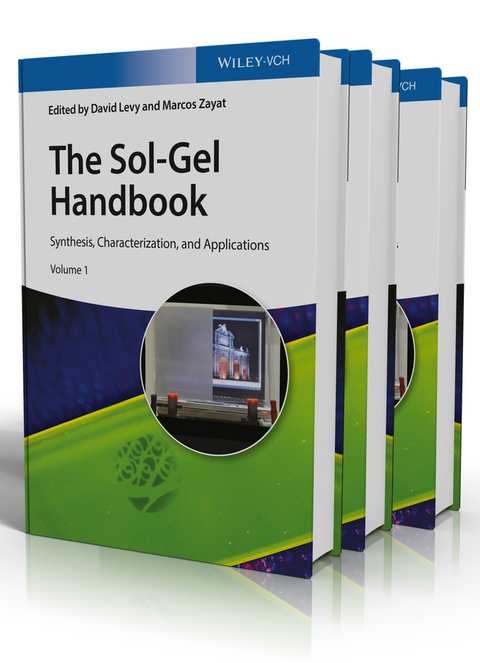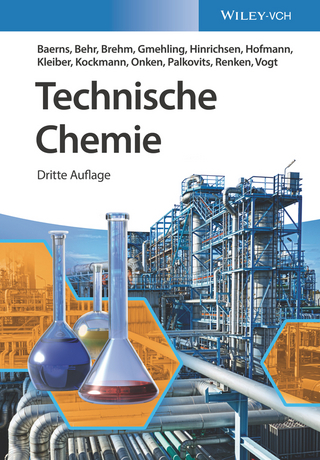The Sol-Gel Handbook
Wiley-VCH (Verlag)
978-3-527-33486-5 (ISBN)
Beschrieben werden u. a. die Synthese, die Eigenschaften und Anwendungsmöglichkeiten.
This comprehensive three-volume handbook brings together a review of the current state together with the latest developments in sol-gel technology to put forward new ideas.
The first volume, dedicated to synthesis and shaping, gives an in-depth overview of the wet-chemical processes that constitute the core of the sol-gel method and presents the various pathways for the successful synthesis of inorganic and hybrid organic-inorganic materials, bio- and bio-inspired materials, powders, particles and fibers as well as sol-gel derived thin films, coatings and surfaces.
The second volume deals with the mechanical, optical, electrical and magnetic properties of sol-gel derived materials and the methods for their characterization such as diffraction methods and nuclear magnetic resonance, infrared and Raman spectroscopies.
The third volume concentrates on the various applications in the fields of membrane science, catalysis, energy research, biomaterials science, biomedicine, photonics and electronics.
David Levy is a Research Professor and head of the Sol-Gel Group at the Materials Science Institute of Madrid (ICMM) of the Consejo Superior de Investigaciones Cientí cas. His research interests are optical materials (bulk materials; thin- lm coatings as AR optical coatings, protection transparent coatings and functional coatings; oxide nanoparticles) and liquid crystal materials, by Sol-Gel processing and their applications. During his time at The Hebrew University of Jerusalem David Levy pioneered the sol-gel process for the preparation of organically doped silica-gel glasses. He has more than 130 publications and a number of patents to his name, and has received numerous prizes in recognition of his groundbreaking work on sol-gel materials, including the First Ulrich Prize and the nomination to King Juan Carlos-I research award.
Marcos Zayat is currently vice-director of the Materials Science Institute of Madrid (ICMM). His scienti c interests are centered on the design of new optical coatings and the characterization of their physicochemical properties. After having obtained his PhD in Materials Science from The Hebrew University of Jerusalem in 1997, Marcos Zayat joined the ICMM where he continues developing sol-gel materials for optical and electrooptical applications. He has published more than fty original articles in prestigious scienti c journals.
VOLUME 1: SYNTHESIS AND SHAPING
SOL-GEL CHEMISTRY
Chemistry and Fundamentals of the Sol-Gel Process
Green Chemistry and Non-Conventional Routes
Precursors, Chemistry, Synthesis, Solution (Alkoxides, Polymeric, Aqueous, Metal Salts)
Reactions towards Nanostructured or Multi-Component Oxides
SPECIAL TECHNIQUES USED IN SOL-GEL PROCESSING
Non-Hydrolytic Sol-Gel Technology
Ultraviolet (UV) Irradiation Assisted Processing
Ultrasound
ORGANIC-INORGANIC HYBRID MATERIALS
Molecular Chemistry and Approaches
Synthesis Strategies
Properties and Applications
BIOMATERIALS, BIOHYBRIDS AND BIOINSPIRED MATERIALS
Biohybrids and Related Materials
Bioceramics, Biocompatible and Environmentally-friendly Materials
Medical Applications
POWDERS, PARTICLES, BULK-MATERIALS, FIBERS AND NON-OXIDE MATERIALS
Sol-Gel Derived Powders (Micro-, Nano- Particles and Spheres); Properties and Applications
Formation of Bulk Materials (Ceramics, Glasses)
Self-Assembling
Processing of Fibers
Formation and Processing of Oxynitride Glasses and Nitrides, Carbides, Fluoride and Sulfide Materials
Composites
THIN FILMS, COATINGS AND SURFACES
Fundamentals of Sol-Gel Coatings
Chemistry and Deposition Methods of Sol-Gel Thin-Films
Thick Films
Special Coatings
PROCESSING OF POROUS MATERIALS AND AEROGELS
Morphology Control
Formation of Ordered Macroporous and Mesoporous Materials
Supramolecular and and Hierarchically Structured Sol-Gel Materials
Aerogels, Foams and Insulating Materials
VOLUME 2: PROPERTIES
STRUCTURAL AND RHEOLOGICAL CHARACTERIZATION
X-ray and Neutron Diffraction Studies
Solid State NMR
IR, XPS, Raman and Brillouin Spectroscopies
Surface and Porosity Characterization
New Characterization Techniques
MECHANICAL PROPERTIES
Mechanical Properties of Gels
Mechanical Properties of Sol-Gel Coatings
Mechanical Properties of Organic-Inorganic Hybrids
OPTICAL AND PHOTONIC PROPERTIES
Optics: Photophysics, Waveguides, Fluorescence, Nonlinear Optical Properties
Photonics
ELECTRICAL, SEMICONDUCTOR AND MAGNETIC PROPERTIES
Ferroelectric and Piezoelectric Properties
Electrical Properties, Electrodes
Magnetic and Magnetooptical Materials
Transparent Materials and Semiconductors
Graphene-based Materials
VOLUME 3: APPLICATIONS
APPLICATIONS FOR MEMBRANES AND CATALYSTS
Catalysts, Biocatalysts, Photocatalysts
Sensors and Controlled Release Applications
ENVIRONMENT AND ENERGY
Solar Cells
Battery and Fuel Cell Applications
Sol-Gel Derived Silicate Based Composites
Sol-Gel Protective, Conservation and Decorative Coatings
Green Materials
Solar and Space applications
APPLICATIONS TO ORGANIC AND BIO-MATERIALS
Fullerene, Nano-Composites, Nanotubes
Biomedical Applications
Entrapment and Encapsulation of Organic Molecules, Enzymes, Antibodies and Bacteria
FUNCTIONAL MATERIALS
Colored Coatings (Dyes, Metals and Pigments)
Micropatterning
Reflective and Antireflective Coatings
Coatings Applied to Windows and Devices
PHOTONIC SENSORS INCLUDING BIOSENSORS
Applications of PDMS as Microfluidic Channels in Sensor Devices
Enzyme Sensors
Using Sol-Gel Processes to Make Laser Devices
INDUSTRIALIZATION OF SOL-GEL SCIENCE & TECHNOLOGY AND INNOVATIVE APPLICATIONS
Practical Examples
Others
PART I: SOL-GEL CHEMISTRY AND METHODS
Chemistry and Fundamentals of the Sol?Gel Process
Nonhydrolytic Sol?Gel Methods
Integrative Sol?Gel Chemistry
Synthetic Self-Assembly Strategies and Methods
Processing of Sol?Gel Films from a Top-Down Route
Sol?Gel Precursors
PART II: SOL-GEL MATERIALS
Nanoparticles and Composites
Oxide Powders and Ceramics
Thin Film Deposition Techniques
Monolithic Sol?Gel Materials
Hollow Inorganic Spheres
Sol?Gel Coatings by Electrochemical Deposition
Nanofibers and Nanotubes
Nanoarchitectures by Sol?Gel from Silica and Silicate Building Blocks
Sol?Gel for Metal Organic Frameworks (MOFs)
Silica Ionogels and Ionosilicas Aerogels
Ordered Mesoporous Sol?Gel Materials: From Molecular Sieves to Crystal-Like Periodic Mesoporous Organosilicas
Biomimetic Sol?Gel Materials
PART III: CHARACTERIZATION TECHNIQUES FOR SOL-GEL MATERIALS
Solid-State NMR Characterization of Sol?Gel Materials: Recent Advances
Time-Resolved Small-Angle X-Ray Scattering
Characterization of Sol?Gel Materials by Optical Spectroscopy Methods
Properties and Applications of Sol?Gel Materials: Functionalized Porous Amorphous Solids (Monoliths)
Sol?Gel Deposition of Ultrathin High-¿ Dielectric Films
PART IV: PROPERTIES
Functional (Meso)Porous Nanostructures
Sol?Gel Magnetic Materials
Sol?Gel Electroceramic Thin Films
Organic?Inorganic Hybrids for Lighting
Sol?Gel TiO2 Materials and Coatings for Photocatalytic and Multifunctional Applications
Optical Properties of Luminescent Materials
Better Catalysis with Organically Modified Sol?Gel Materials
Hierarchically Structured Porous Materials
Structures and Properties of Ordered Nanostructured Oxides and Composite Materials
PART V: APPLICATIONS
Sol?Gel for Environmentally Green Products
Sol?Gel Materials for Batteries and Fuel Cells
Sol?Gel Materials for Energy Storage
Sol?Gel Materials for Pigments and Ceramics
Sol?Gel for Gas Sensing Applications
Reinforced Sol?Gel Silica Coatings
Sol?Gel Optical and Electro-Optical Materials
Luminescent Solar Concentrators and the Ways to Increase Their Efficiencies
Mesoporous Silica Nanoparticles for Drug Delivery and Controlled Release Applications
Sol?Gel Materials for Biomedical Applications
Self-Healing Coatings for Corrosion Protection of Metals
Aerogel Insulation for Building Applications
Sol?Gel Nanocomposites for Electrochemical Sensor Applications
| Erscheint lt. Verlag | 23.9.2015 |
|---|---|
| Zusatzinfo | 443 Abb. (193 Farbabb.) |
| Verlagsort | Berlin |
| Sprache | englisch |
| Maße | 170 x 244 mm |
| Gewicht | 3905 g |
| Einbandart | gebunden |
| Themenwelt | Naturwissenschaften ► Chemie ► Technische Chemie |
| Technik ► Maschinenbau | |
| Schlagworte | Anorganische Chemie • Chemie • Chemistry • Dünne Schichten, Oberflächen u. Grenzflächen • Dünne Schichten, Oberflächen u. Grenzflächen • Inorganic Chemistry • Materials Science • Materialwissenschaften • Nanomaterial • Nanomaterialien • nanomaterials • Nanostrukturiertes Material • Nanotechnologie • nanotechnology • Oberflächen- u. Kolloidchemie • Oberflächen- u. Kolloidchemie • Sol-Gel • Surface & Colloid Chemistry • Thin Films, Surfaces & Interfaces |
| ISBN-10 | 3-527-33486-6 / 3527334866 |
| ISBN-13 | 978-3-527-33486-5 / 9783527334865 |
| Zustand | Neuware |
| Haben Sie eine Frage zum Produkt? |
aus dem Bereich




